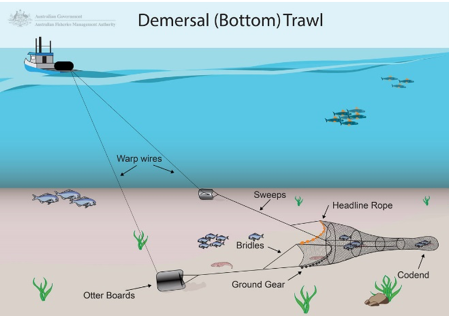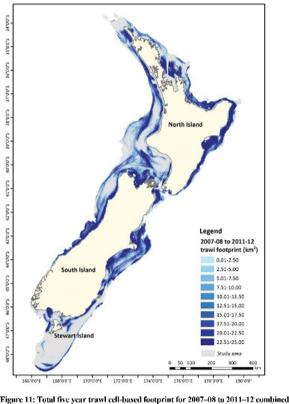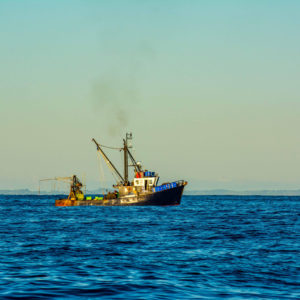What is trawling?
A trawl is a tunnel shaped fishing net which is towed through the water by a vessel on the surface of the water. As the net is towed through the water strains out through the mesh entrapping the fish and retaining them in the cod end of the trawl bag.
The size of the trawl generally relates to the pulling power of the vessel, the larger the vessel, the bigger net it can tow. The trawl speed can be adjusted to target species and usually ranges from 1.5 knots to 5 knots.
What is bottom trawling?

Bottom trawling is an industrial fishing method that involves dragging a large, weighted net along the seafloor with the intention of mass collection. Trawl gear includes bobbin chains that roll over the seabed, the trawl doors that keep the net mouth open, the trawl net, and the cod end which is the trawl bag where fish are collected. Floats are attached to the upper front part of the trawl net to provide buoyancy and keep the trawl net open. The bottom front part of the trawl net ensures that bobbins or rigging remain in contact with the seafloor.
Two trawl doors, to the front of each side of the trawl, keep the trawl net open horizontally when towed. A trawl wire is run from the vessel and attached to each trawl door. The extension of the trawl, how far behind the vessel it is towed, the depth and speed of the tow varies depending on the target species and area fished.
Bottom trawling is the most common trawl method used in New Zealand. Other methods include mid-water trawling, pair trawling and pelagic.
Why is bottom trawling unpopular with the public?
The three main issues with bottom trawling are bulk harvesting, non-selective harvest, and benthic damage.
1. Bulk harvesting
Bottom trawling allows for large amounts of fish to be caught during one fishing event. The fish that are caught in the early part of the trawl end up being crushed under the weight of fish as more are gathered in the net. Much of the catch is damaged and is of poor quality when landed, fetching low returns.
2. Non-selective harvest
Trawling is a non-selective method so many varieties of finfish and other organisms are captured even if they are not the target species. This bulk harvesting of organisms can cause many ecological problems, unbalancing the natural levels of each species in the ecosystem and affecting their reproductive capabilities. Deep-sea fish do not easily repopulate once overfished due to their low reproduction rates.
Non-targeted species can become overfished in the pursuit of the target species. This damage often goes unnoticed because research effort and dollars are mostly directed at commercially important species.
The use of bottom trawlers in mixed finfish fisheries is wasteful. Trawlers capture large amounts of unwanted catch. That can be species that fishermen have no quota for, non-marketable species or size of fish, and damaged fish. This often leads to fishermen dumping the unwanted catch, which is often dead or dying.
3. Benthic damage
The destruction of the seafloor has negative impacts on the organisms and fish harvested. It also takes away whole ecosystems that are used as food and shelter for many species. This destruction will often cause permanent damage to marine ecosystems.
Studies show that a century of ever-expanding use of heavy, bottom contact mobile gear has transformed the sea floor from a thriving benthic community of organisms to a desert of fine silt. This silt is re-suspended and distributed further each time trawl gear is towed across the seafloor.
How much bottom trawling occurs in NZ?

The latest available data shows that in 2016 there were 26,000 seabed contact tows in New Zealand waters.
- Some areas of the seabed have been trawled every year for 27 years.
- About 76 square kilometres of seabed was trawled for the first time in 2016.
- In the past decade the area of seabed trawled has ranged between 40,000 and 44,000 square kilometres.
- Between 2008 and 2012 in coastal waters out to 250 metres deep there were more than 280,000 bottom trawl events.
- Bottom trawling occurs in 50.3% of the seafloor area available to trawling.
- The majority of trawl effort in waters out to 250 m deep is targeting tarakihi. Other target species include snapper, gurnard, flatfish (flounders), jack mackerel, trevally and john dory.
What is LegaSea’s view on bottom trawling?
LegaSea’s policy – Remove industrial fishing methods such trawling, seining and dredging from the inshore zone.
This is one of five policies from the Manifesto developed to restore New Zealand’s inshore fisheries to abundant levels and return the marine environment to a more productive ecosystem. https://legasea.co.nz/about-us/what-is-legasea/manifesto/
Underpinning this policy is research and traditional knowledge shared with us. Together it shows that prior to industrial fishing the inshore zone was highly productive, providing nursery functions for dozens of species and supporting marine diversity through layers of ecosystem services.
Bottom trawling and the damage it causes is no longer acceptable in inshore waters. Consistent use of more sustainable fishing practices would allow fish stocks to recover. Hand and long line fishing, and trapping, drastically reduce the number of fish caught and allow for non-targeted species to be released more easily and for stock populations to recover at an increased rate. A coastal zone where this low impact commercial fishing, Maori customary and recreational fishing can co-exist will deliver more value to New Zealanders and better protect biodiversity.
A more productive inshore zone would also enable coastal communities and local businesses to rebuild through expanding employment and trading opportunities. This has got to be a better deal than what we have now, which is poor Ministerial decisions enabling maximum commercial catches using indiscriminate bulk harvesting and trawling in our precious inshore waters.
Keen to help? Please share & donate.
–
More information
Baird, S.J.; Hewitt, J.E.; Wood, B.A. (2015). Benthic habitat classes and trawl fishing disturbance in New Zealand waters shallower than 250 m. New Zealand Aquatic Environment and Biodiversity Report No.144. 184 p.
Clark MR, Bowden DA, Rowden AA and Stewart R (2019). Little evidence of benthic community resilience to bottom trawling on seamounts after 15 years. https://www.frontiersin.org/articles/10.3389/fmars.2019.00063/full
Ministry for the Environment & Stats NZ (2019). New Zealand’s Environmental Reporting Series: Environment Aotearoa 2019. https://www.mfe.govt.nz/publications/environmental-reporting/environment-aotearoa-2019
LegaSea Manifesto – Policies developed to restore New Zealand’s inshore fisheries to abundant levels and return the marine environment to a more productive ecosystem. https://legasea.co.nz/about-us/what-is-legasea/manifesto/
Trawling banned 600 years ago – LegaSea article. https://legasea.co.nz/2016/08/26/trawling-banned-600-years-ago/
Joint effort to save “kauri forests of our ocean” – media release by the Deep Sea Conservation Coalition. https://legasea.co.nz/2019/05/15/joint-effort-to-save-kauri-forests-of-our-ocean/




